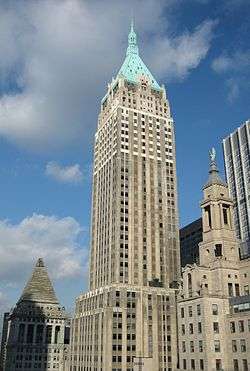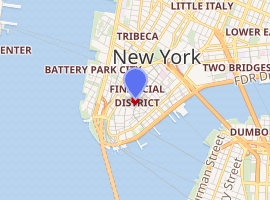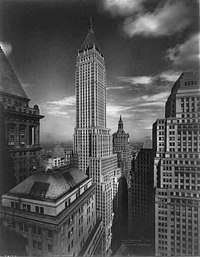40 Wall Street
40 Wall Street, also known as the Trump Building, is a 71-story, 927-foot-tall (283 m) neo-Gothic skyscraper between Nassau Street and William Street in the Financial District of Manhattan, New York City. Erected in 1929-1930 as the headquarters of the Manhattan Company, the building was originally known as the Bank of Manhattan Trust Building,[7] and also as the Manhattan Company Building,[5] until its founding tenant merged to form the Chase Manhattan Bank.[8] It was designed by H. Craig Severance with Yasuo Matsui and Shreve & Lamb.
| 40 Wall Street | |
|---|---|
 40 Wall Street in December 2005 | |

| |
| Alternative names | The Trump Building, Manhattan Company Building |
| Record height | |
| Tallest in the world from April 1930 to May 27, 1930[I] | |
| Preceded by | Woolworth Building |
| Surpassed by | Chrysler Building |
| General information | |
| Architectural style | Neo-Gothic |
| Location | 40 Wall Street, New York, NY 10005 |
| Coordinates | 40.706964°N 74.009672°W |
| Construction started | May 1, 1929[1] |
| Completed | May 1, 1930[2] |
| Opening | May 26, 1930[3] |
| Landlord | Donald Trump |
| Height | |
| Architectural | 927 ft (283 m)[4] |
| Top floor | 836 ft (255 m)[4] |
| Technical details | |
| Floor count | 72[4] |
| Floor area | 1,111,675 sq ft (103,278.0 m2) |
| Lifts/elevators | 36[4] |
| Design and construction | |
| Architect | H. Craig Severance (main architect), Yasuo Matsui (associate architect), Shreve & Lamb (consulting architect) |
| Website | |
| www.40wallstreet.com | |
Manhattan Company Building | |
NYC Landmark No. 1936
| |
| Location | 40 Wall Street, New York, NY |
| Area | less than one acre |
| Built | 1929–1930 |
| Architect | H. Craig Severance, Yasuo Matsui, et al. |
| Architectural style | Skyscraper |
| NRHP reference No. | 00000577[5] |
| NYCL No. | 1936 |
| Significant dates | |
| Added to NRHP | June 16, 2000 |
| Designated NYCL | December 12, 1936 |
| References | |
| [4][6] | |
Plans for 40 Wall Street were revealed in April 1929, with the Manhattan Company as the primary tenant. The structure was completed in May 1930 after 11 months of construction. 40 Wall Street and the Chrysler Building were competing for the distinction of "world's tallest building" at the time of both buildings' construction, leading to several modifications in plans, though the Chrysler Building ultimately emerged as the world's tallest building. Since 1995, the building has been owned by Donald Trump.
The building is located on an L-shaped site. While the lower section has a facade of limestone, the upper stories incorporate a buff-brick facade and contain numerous setbacks. Other features of the facade include spandrels between the windows on each story, which are recessed behind the vertical piers on the facade. At the top of the building is a pyramid with a spire at its pinnacle. 40 Wall Street has been listed on the National Register of Historic Places since 2000 and was designated as a New York City landmark in 1995.
Architecture

The building was designed by H. Craig Severance, along with Yasuo Matsui (associate architect), and Shreve & Lamb (consulting architects). Purdy and Henderson were the structural engineers. Edward F. Caldwell & Co. designed the lighting. Der Scutt of Der Scutt Architect designed the lobby and entrance renovation.[8] Its pinnacle reaches 927 feet (283 m), making 40 Wall Street the tallest building in the world for a brief period, until it was surpassed by a spire attached to the Chrysler Building a few months later.[9]
The Bank of Manhattan Building had an observation deck on the 69th and 70th floors, located 836 feet (255 m) above the street, with the observatory able to fit up to 100 people.[10] A bronze statue of Oceanus, a Greek god, was also erected atop the building.[11]
History
Competition for "world's tallest building" title
40 Wall Street was originally proposed by the banker George L. Ohrstrom to be a 47-story tower. Shortly after, Ohrstrom modified his project to have 60 floors, but it was still below the 792-foot (241 m) Woolworth Building and the 808-foot (246 m) Chrysler Building project, announced in 1928.[12] In April 1928, Severance increased 40 Wall's height to 840 feet (260 m) with 62 floors, which would exceed the Woolworth's height by 48 feet (15 m) and the Chrysler's by 32 feet (9.8 m).[12] The two structures started competing for the distinction of "world's tallest building".[13][14] The Empire State Building on 34th Street and Fifth Avenue would enter the competition in 1929. The "Race into the Sky", as popular media called it at the time, was representative of the country's optimism in the 1920s, fueled by the building boom in major cities.[15] The 40 Wall Street tower was revised from 840 feet (260 m) to 925 feet (282 m) in April 1929, making it the world's tallest.[16]:130 Severance increased the height of his project and then publicly claimed the title of the world's tallest building.[17] (This distinction excluded structures that were not fully habitable, such as the Eiffel Tower.)[18] Construction of 40 Wall Street began in May 1929 at a frantic pace, and it was completed twelve months later.[12]
In response, the Chrysler's architect William Van Alen obtained permission for a 38-meter (125 ft) long spire[19]:161[20] and had it secretly constructed inside the frame of the building.[16]:130 The spire was delivered to the site in four different sections.[19]:161 On October 23, 1929, the day before the catastrophic Wall Street Crash of 1929 started, the bottom section of the spire was slowly hoisted to the top of the building's dome and lowered into the 66th floor of the building.[12] The other remaining sections of the spire were hoisted and riveted to the first one in sequential order in 90 minutes,[19]:xiii, 161 helping raise the tower's height to 1,046 feet (319 m),[21][22] greatly exceeding 40 Wall Street's height.[23] Once completed on May 28, 1930, the Chrysler Building surpassed 40 Wall Street as the tallest building in the world, fulfilling Chrysler's dream.[16]:130
Upset by Chrysler's victory, Shreve & Lamb, consulting architects of 40 Wall Street, wrote a newspaper article claiming that their building was the tallest, since it contained the world's highest usable floor. They pointed out that the observation deck in the Bank of Manhattan Building was nearly 100 feet (30 m) above the top floor in the Chrysler Building, whose surpassing spire was strictly ornamental and essentially inaccessible.[20] The Empire State Building was completed eleven months later in May 1931, becoming the world's tallest building in both of those categories, at 1,250 feet (380 m).[9][16]:185
Foreclosure
In 1939, the Marine Midland Trust Company started foreclosure proceedings against the Forty Wall Street Corporation after the corporation defaulted on "payments of interest, taxes and other charges".[24] Bondholders acquired the building in 1940 in a transaction worth almost $11.5 million.[25]
1946 plane crash
On the evening of May 20, 1946, a United States Army Air Forces Beechcraft C-45F Expediter airplane crashed into the north side of the building. The twin-engined plane was heading for Newark Airport on a flight originating at Lake Charles Army Air Field in Louisiana. It struck the 58th floor of the building at about 8:10 PM, creating a 20-by-10-foot (6.1 m × 3.0 m) hole in the masonry, and killing all five aboard the plane, including a WAC officer. The fuselage and the wing of the splintered plane fell and caught onto the 12th story ledge.[26]
Fog and low visibility were identified as the main causes of the crash. At the time of the accident, LaGuardia Field reported a heavy fog that reduced the ceiling to 500 feet (150 m), obscuring the view of the ground for the pilot at the building's 58th story level. Parts of the aircraft and pieces of brick and mortar from the building fell into the street below, but there were no reported injuries to any of the estimated 2,000 workers in the building, nor anyone on the street.[27]
This crash at 40 Wall Street was the second of its kind in New York City's history, the first being when an Army B-25 bomber struck the 78th floor of the Empire State Building in July 1945. The cause of that crash was also fog and poor visibility.[27] The 1946 accident was the last time an airplane accidentally struck a skyscraper in New York City until October 11, 2006, when a small plane carrying New York Yankees pitcher Cory Lidle crashed into a 50-story condo building on Manhattan's Upper East Side.[28][29]
Decline and revival
In 1982, Joseph J. and Ralph E. Bernstein purchased leasing rights of 40 Wall Street and were later found to be acting on behalf of Ferdinand E. Marcos, the President of the Philippines. When Marcos was removed from power and his assets in the United States were frozen, the building was placed in limbo.[30] Citicorp then decided to undertake a $50 million renovation of 40 Wall Street, but the renovation was canceled in 1991 due to concerns that the tenants might move out.[31]
In December 1995, after years of neglect, the lease was transferred to Donald Trump, who later renamed the building the "Trump Building".[32][33] He planned to convert the upper half of it to residential space, leaving the bottom half as commercial space. The cost of converting it to residential space proved to be too high, and it remains 100% commercial space.[34] He tried to sell the building in 2003, expecting offers in excess of $300 million. They did not materialize. In the ninth episode of the fourth season of The Apprentice, Trump claimed he only paid $1 million for the building, but that it was actually worth $400 million. This episode aired November 17, 2005. Trump's legal advisor, George H. Ross, restated this claim in a 2005 book.[35]
On CNBC's The Billionaire Inside, Trump again claimed he paid $1 million for the building, but stated the value as $600 million, a $200 million increase from two years earlier. The episode aired October 17, 2007, on CNBC. However, it has also been reported that Trump paid $10 million for the building and the building is now worth $1 billion.[36] According to 2015 Federal Election Commission filings, Trump has an outstanding mortgage on the property in excess of $50 million.[37] Notable tenants include George Soros' Quantum Group of Funds
In 1995, the building was designated a landmark by the New York City Landmarks Preservation Commission.[38] The tower was the tallest mid-block building in New York City until the completion of One57 in 2014.[39]
See also
- List of tallest buildings in New York City
- Walter J. Hinneberg
References
- Carol Willis. 40 WALL STREET FOUNDATION PHOTOGRAPHS Skyscraper Museum
- Jay Hoster (2014). Early Wall Street 1830-1940. Charleston: Arcadia Publishing. p. 127. ISBN 978-1-4671-2263-4. Retrieved June 7, 2018.
- dankwa, e t (June 27, 2014) THE 40 WALL STREET Archived June 18, 2016, at the Wayback Machine Museum of Modern Art
- "40 Wall Street". CTBUH Skyscraper Center.
- "National Register Information System". National Register of Historic Places. National Park Service. March 13, 2009.
- 40 Wall Street at Emporis
- "40 Wall Street – The Trump Building". Wirednewyork.com.
- White, Norval & Willensky, Elliot (2000). AIA Guide to New York City (4th ed.). New York: Three Rivers Press. p. 19. ISBN 978-0-8129-3107-5.
- "The History of Measuring Tall Buildings". Council on Tall Buildings and Urban Habitat. Archived from the original on April 10, 2012. Retrieved May 3, 2012.
- "TOWER RISES 836 FEET.; Lofty Observation Floor in Bank of Manhattan Building" (PDF). The New York Times. June 1, 1930. ISSN 0362-4331. Retrieved November 7, 2017.
- "OCEANUS ADORNS FACADE.; New Skyscraper for Bank of Manhattan Building Gets Statue" (PDF). The New York Times. April 26, 1930. ISSN 0362-4331. Retrieved November 7, 2017.
- Gray, Christopher (November 15, 1992). "Streetscapes: 40 Wall Street; A Race for the Skies, Lost by a Spire". The New York Times. Retrieved November 3, 2017.
- Emporis GmbH. "Emporis Data "...a celebrated three-way race to become the tallest building in the world."". Emporis.com. Retrieved September 27, 2010.
- "The Manhattan Company – Skyscraper.org; "...'race' to erect the tallest tower in the world."". Skyscraper.org. Retrieved September 27, 2010.
- Rasenberger, Jim (2009). High Steel: The Daring Men Who Built the World's Greatest Skyline, 1881 to the Present. HarperCollins. pp. 388–389. ISBN 978-0-06-174675-8.
- Tauranac, John (2014). The Empire State Building: The Making of a Landmark. New York: Scribner. ISBN 978-0-684-19678-7.
- Emporis Data – See source no.4 line 4; "Briefly held the world's tallest title until it was eclipsed by the spire of Chrysler Building."
- "Council on Tall Buildings and Urban Habitat". Ctbuh.org.
- Stravitz, David (2002). The Chrysler Building: Creating a New York Icon Day by Day. New York: Princeton Architectural Press. ISBN 1-56898-354-9.
- Binders, George (2006). 101 of the World's Tallest Buildings. Images Pub. p. 102. ISBN 978-1-86470-173-9.
- Curcio, V. (2001). Chrysler: The Life and Times of an Automotive Genius. Automotive History and Personalities. Oxford University Press. p. 426. ISBN 978-0-19-514705-6.
- Cobb, H.M. (2010). The History of Stainless Steel. Asm Handbook. ASM International. p. 110. ISBN 978-1-61503-011-8.
- Willis, Carol; Friedman, Donald (1998). Building the Empire State. New York: W.W. Norton. p. 14. ISBN 978-0-393-73030-2.
- "START FORECLOSURE ON 40 WALL STREET; Trustee Presents Reorganization Plan for Skyscraper" (PDF). The New York Times. May 25, 1939. ISSN 0362-4331. Retrieved November 7, 2017.
- "Bondholders Acquire 40 Wall Street Building On Bid of $11,489,500 in Reorganization Plan" (PDF). The New York Times. September 26, 1940. ISSN 0362-4331. Retrieved November 7, 2017.
- "PLANE HITS WALL ST. BANK (May 21, 1946)". Archives.chicagotribune.com.
- "Pilot Lost in Fog," The New York Times, May 21, 1946, p. 1
- Levy, Matthys and Salvadori, Mario, Why Buildings Fall Down: How Structures Fail (2002), p. 30: "… no plane has accidentally hit a skyscraper since the Empire State and Wall Street catastrophes."
- Yankees' Lidle killed in plane crash, Mark Feinsand, MLB.com, October 11, 2006
- Oser, Alan S. "Perspectives: 40 Wall Street; Asian Buyer Accepts a Leasing Challenge", New York Times, June 20, 1993.
- Dunlap, David W. (November 10, 1991). "Commercial Property: 40 Wall Street; Citicorp Aborts $50 Million Financing of Renovation". The New York Times. ISSN 0362-4331. Retrieved November 7, 2017.
- News, Bloomberg Business (December 7, 1995). "40 Wall Street Is Sold to Trump". The New York Times. ISSN 0362-4331. Retrieved November 7, 2017.
- "Meet the obscure German magnates who actually own Trump's most valuable building". The Real Deal. January 6, 2017.
- Ross, George H. (2005). Trump Strategies for Real Estate: Billionaire Lessons for the Small Investor. John Wiley & Sons. p. 51. ISBN 9780471736431.
- Ross, George H. (2005). Trump Strategies for Real Estate: Billionaire Lessons for the Small Investor. John Wiley & Sons. p. 50. ISBN 9780471736431.
- "Trump fills 40 Wall Street with low rents, incentives", The Real Deal, January 23, 2012.
- Zurcher, Anthony (July 23, 2015). "Five take-aways from Donald Trump's financial disclosure". BBC. Retrieved March 2, 2016.
- Landmarks Preservation Commission 1995, p. 1.
- "FACT CHECK: Did Trump Brag He Had the 'Tallest Building in Manhattan' After the 9/11 Attacks?". Snopes.com. Retrieved February 24, 2019.
Further reading
- Bascomb, Neal (2003). Higher: A Historic Race to the Sky and the Making of a City. Doubleday. ISBN 9780385506618.
- "Historic Structures Report: Manhattan Company Building" (PDF). National Register of Historic Places, National Park Service. June 16, 2000.
- "Manhattan Company Building" (PDF). New York City Landmarks Preservation Commission. December 12, 1995.
External links
| Wikimedia Commons has media related to 40 Wall Street. |
- The Trump Building on CTBUH Skyscraper Center
- Wired New York - 40 Wall Street (The Trump Building)
- in-Arch.net: The 40 Wall Street
- 40 Wall Street at Emporis
| Records | ||
|---|---|---|
| Preceded by Woolworth Building |
Tallest building in the world April–May 1930 |
Succeeded by Chrysler Building |
| Tallest building in the United States April–May 1930 | ||

